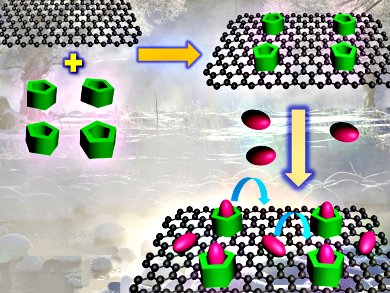Graphene – possessing unique planar structure, remarkable mechanical properties, fascinating electron transfer and exceptional optical properties – holds great promise for potential application in chemical sensors and has aroused considerable attention in recent years. But as a sensor, graphene itself is poorly water-dispersive, hampering the further application in aqueous solutions.
Ying-Wei Yang and his research group, Jilin University, Changchun, China, have covalently modified carboxylatopillar[5]arene (CP5) onto the surface of reduced graphene oxide (RGO) to form RGO-CP5 nanosheets, offering the hybrid materials very good water dispersibility. By fully taking advantage of the fluorescence energy transfer (FRET) and photoinduced charge transfer (PCT) of graphene-based materials and supramolecular host-guest properties of pillar[n]arenes, the researchers used the nanosheets to sense and detect fluorescent dyes such as rhodamine 6G and neutral red. Experimental results showed that quenching of the fluorescence of dyes by the RGO-CP5 nanosheets was much better compared to native RGO.
This new sensing platform holds great potentials in the sensing and detection of analytes, such as functional organic molecules and biological entities, in aqueous solutions.
- Carboxylatopillarene-Modified Reduced Graphene Oxides with High Water Dispersibility for Fluorescent Dye Sensing,
Ting Zhou, Hao Yu, Ming-Qiang Liu, Ying-Wei Yang,
Chin. J. Chem. 2015.
DOI: 10.1002/cjoc.201400238



